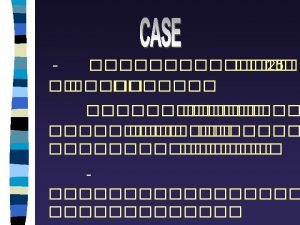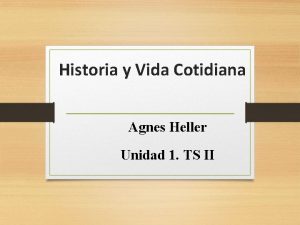David Sadava David M Hillis H Craig Heller






























- Slides: 30


David Sadava, David M. Hillis, H. Craig Heller, May R. Berenbaum La nuova biologia. blu Anatomia e fisiologia dei viventi S

Immunology: Animal Defense Systems

What Are the Major Defense Systems of Animals? Animals have various means of defense against pathogens—organisms or viruses that cause disease. Defense systems are based on the recognition of self and non self molecules. Two types of defense mechanisms: Innate defenses (non-specific) act rapidly; include barriers such as skin, phagocytic cells, and toxins. Adaptive defenses are aimed at specific pathogens. Slow to develop and long-lasting; e. g. , antibodies for a specific virus. Evolved in vertebrates.

The Human Lymphatic System Components of mammalian defense systems are dispersed throughout the body. Lymphoid tissues include thymus, bone marrow, spleen, and lymph nodes.

What Are the Major Defense Systems of Animals? Lymph: fluid derived from blood and other tissues. From tissues, lymph moves into lymph system vessels. Lymph vessels join and eventually form the thoracic duct, which joins the circulatory system at a major vein near the heart. Lymph nodes are small round structures at many sites along lymph vessels—contain lymphocytes, a type of white blood cell.

What Are the Characteristics of the Innate Defenses? Innate defenses are general mechanisms to stop pathogens from invading or quickly eliminate those that do. They are genetically programmed: “ready to go. ” In mammals, they include physical barriers as well as cellular and chemical defenses.

What Are the Characteristics of the Innate Defenses? If a pathogen lands inside nose or an internal organ: mucus in the nose, respiratory, digestive, and urogenital systems traps microorganisms. Cilia continuously move the mucus and its trapped debris away. Lysozyme, made by mucous membranes, attacks bacterial cell walls and causes them to burst (lyse).

What Are the Characteristics of the Innate Defenses? Defensins, made by mucous membranes, are peptides with hydrophobic domains; toxic to many pathogens. Defensins insert themselves into the plasma membrane of the pathogen and make it permeable.

What Are the Characteristics of the Innate Defenses? Complement and interferon proteins are produced in response to pathogens. Vertebrate blood has over 20 different proteins that make up the antimicrobial complement system. Interferons are signaling molecules that increase resistance of neighboring cells to a pathogen. They bind to uninfected cells, stimulating a signaling pathway that inhibits viral reproduction.

What Are the Characteristics of the Innate Defenses? Phagocytes travel in lymph and blood, and may move out of vessels and into tissues. They engulf foreign cells, viruses, and fragments. Natural killer cells can distinguish virus-infected cells and some tumor cells from normal cells. • Can initiate apoptosis in these cells • Can interact with adaptive defense mechanisms and lyse cells labeled by antibodies.

What Are the Characteristics of the Innate Defenses? Inflammation is a response to injury or infection. It isolates damaged areas to stop the spread, recruits cells and molecules to the area to kill invaders, and promotes healing. The redness and heat of inflammation result from dilation and leakiness of blood vessels in the affected area.

What Are the Characteristics of the Innate Defenses? Histamine and other signals attract phagocytes; they engulf invaders and dead cells. Phagocytes produce cytokines, which can signal the brain to produce fever.

What Are the Characteristics of the Innate Defenses? Increased body temperature accelerates lymphocyte production and phagocytosis; also inhibits growth of some pathogens. After inflammation, pus may accumulate—leaked fluid and dead cells; it is gradually consumed by macrophages. Sepsis: response to a bacterial infection may not remain local and spreads throughout the bloodstream.

How Does Adaptive Immunity Develop? The adaptive immune system has four key traits: • Specificity: T cell receptors and antibodies bind to specific non-self molecules (antigens). Specific sites on the antigens are called antigenic determinants. • Distinguishing self from non-self: every cell in the body has many different antigens; the immune system must be able to recognize them all and not attack them.

How Does Adaptive Immunity Develop? • Diversity: the immune system must respond to a wide variety of pathogens. Humans can respond specifically to about 10 million different antigens. • Immunological memory: after one response to a pathogen, the immune system “remembers” the pathogen and can respond more quickly and powerfully if that pathogen invades again. Vaccination introduces an antigen and the immune system remembers it.

How Does Adaptive Immunity Develop? Clonal selection The lymphocytes proliferate and generate a clone of genetically identical cells. Effector cells (plasma cells) attack the antigen. Memory cells are longlived cells that can divide on short notice to produce effector cells and more memory cells.

How Does Adaptive Immunity Develop? Adaptive immune system has two types of responses that operate simultaneously and cooperatively. 1. Humoral immune response—relies on B cells making antibodies; Antibodies belong to a protein class called immunoglobulins.

What Is the Humoral Immune Response? All are tetramers with two light chains and two heavy chains, held together by disulfide bonds. Each polypeptide chain has a constant region and a variable region.

What Is the Humoral Immune Response? Ability to bind two antigen molecules at once, along with multiple epitopes on many antigens results in large complexes that are easy targets for ingestion and breakdown by phagocytes.

Antibody Classes Constant region determines the class of antibody— the function and destination.

What Is the Cellular Immune Response? 2. Cellular immune response involves two types of effector T cells: • T-helper cells (TH) • Cytotoxic T cells (TC) T cell specific membrane receptors bind only to antigens displayed by an MHC (Major histocompatibility complex) on the surface of a target cell. • Class I MHC • Class II MHC

What Is the Cellular Immune Response? Clonal deletion helps distinguish self from non-self. In the thymus, during early differentiation, any immature B or T cell that shows potential to mount an immune response against self antigens undergoes programmed cell death (apoptosis).

The Adaptive Immune System

How Does Adaptive Immunity Develop? Primary immune response: when antigen is first encountered, “naïve” lymphocytes proliferate to produce clones of effector and memory cells. Secondary immune response: when antigen is encountered again, memory cells proliferate and launch an army of plasma cells and effector T cells. Because of immunological memory, exposure to many diseases provides natural immunity.

How Does Adaptive Immunity Develop? Vaccination provides artificial immunity by introducing an antigen that does not cause disease. • Inactivation • Attenuation • Recombinant DNA technology

What Happens When the Immune System Malfunctions? Allergic reactions occur when the immune system overreacts or is hypersensitive to an antigen.

What Happens When the Immune System Malfunctions? Autoimmunity: errors in T cell selection result in T cells that bind to self antigen-MHC complexes. Some autoimmune diseases: • Systemic lupus erythematosis (SLE) • Rheumatoid arthritis • Hashimoto’s thyroiditis • Insulin-dependent diabetes mellitus (type I)

What Happens When the Immune System Malfunctions? TH cells are the target of human immunodeficiency virus (HIV), the retrovirus that results in (AIDS) acquired immune deficiency syndrome. HIV can be transmitted by bodily fluids containing the virus (blood, semen, vaginal fluid, or breast milk).

Adapted from Life: The Science of Biology, Tenth Edition, Sinauer Associates, Sunderland, MA, 2014 Inc. All rights reserved
 David sadava
David sadava Mueller hillis maneuver
Mueller hillis maneuver Craig heller
Craig heller Heller h 4000
Heller h 4000 Léo heller
Léo heller Heller zsolt
Heller zsolt Ultrageneralizacion heller
Ultrageneralizacion heller Noah heller
Noah heller Matthieu heller
Matthieu heller Lex rogata
Lex rogata Annette heller
Annette heller Herman heller
Herman heller Desiree heller
Desiree heller Heller fundraising group
Heller fundraising group Katherine heller duke
Katherine heller duke Dor anterior fundoplication
Dor anterior fundoplication Greyheller mobile
Greyheller mobile Grunnisolasjon
Grunnisolasjon Michael craig martin analysis
Michael craig martin analysis Craig nicolson
Craig nicolson Craig marlatt geography
Craig marlatt geography Types of stuttering
Types of stuttering Craig hatto
Craig hatto Kalani craig
Kalani craig Craig ferrans
Craig ferrans Craig setzer
Craig setzer Dr claire beimesch
Dr claire beimesch Craig kennady
Craig kennady Craig n owens
Craig n owens Climograph of toronto
Climograph of toronto Lorraine craig imperial
Lorraine craig imperial




















































